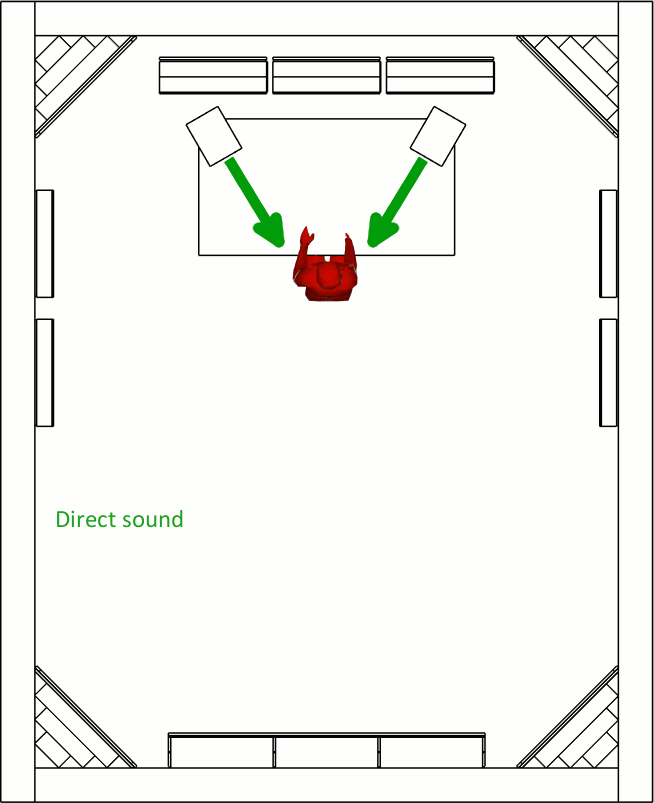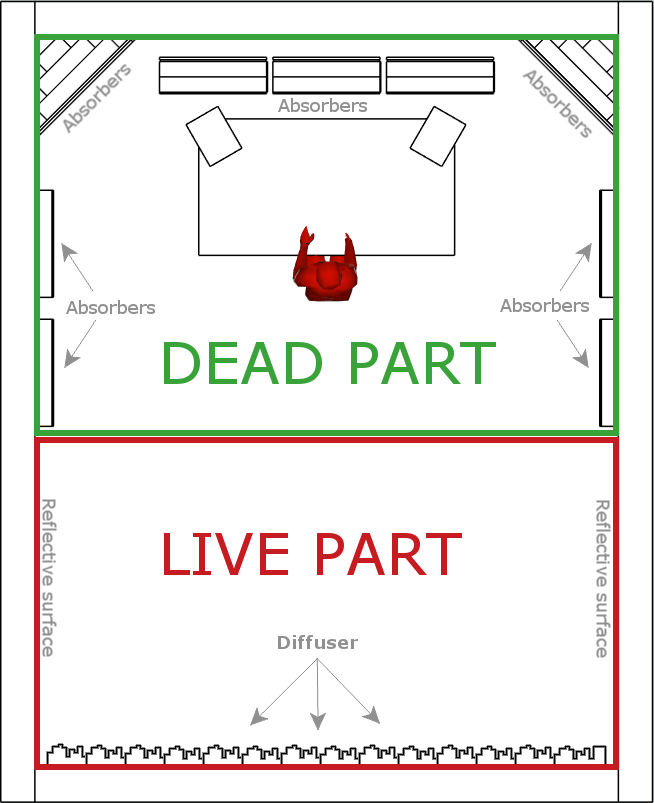First reflection, Flutter echo, Comb Filtering
Doesn't matter if your production is focused on the rock music, hip-hop beats or electronic music. All styles have common attribute - the track has to be in appropriate sound quality. In order to achieve it is need to have good sounding room. For this purpose is need to do several things - properly layout the setup (speakers, listening position..) and install several elements that can affect the room sound in the right way. The reason why to do that are sound reflections that behave differently regard to its frequency. I don't want to go into physical theory details, but for better understanding is good to be familiar with these few basics.
We can start with simpler ones and it is undesired behave of the sound waves in the middle and the high frequency range - their reflections and unwanted caused effects.
First / Early reflections zone
To get good sound of your track is necessary to keep all sounds (instruments) in balance without undesired overlay in terms of frequencies, timing and stereo image. Perfectly sounding track has to have perfectly balanced frequencies, placed instruments in stereo image and tidy dynamics - these are essential elements of the sound design and track mixdown. In order to achieve balance in the mix you need to clearly hear what is going from the speaker. If your room is not enough treated against reflections from the walls, ceiling and floor (all surfaces) you will hear signal from the speaker in combination with its reflection. Since reflected sound travels to your ears by path with longer length in compare with straight directed sound, they are shifted in phase (have different timing) what causes its unwanted cancellation or vice versa its cumulation (interference of two waves with different phase). As result you will hear the original sound that comes from the monitors directly to your ears distorted by reflections of original sound. Even more you will hear the signal from the left speaker with its shifted reflections plus signal from the right speaker reflected from different surfaces and also all shifted reflections. As the end to your ears goes messed signal (sound). Proper perception of original sound is impossible and subsequently it prevents you to reach satisfying results. Most significant distortion caused by reflections arises in rooms with parallel surfaces. Treatment of first reflection zone helps to eliminate these undesired effects. For better imagination about first reflection zone you can check this great video about first/early reflections and its treatment made by GIK Acoustics.


Flutter echo
Flutter echo is reflection of the original sound in the room with parallel surfaces with a hard finish (walls, floor and ceiling) where the sound is reflected forth and back between these walls - ringing reverberation that remains after the direct sound has stopped. Because the wavelengths of the middle and high frequency sounds are so much shorter than the lows, the reflections bounce directionally. The resulting sound is this ringing flutter echo rather than the boomy standing waves described in another article.
Flutter echo affects music by adding an unpleasant harshness to the mid-range and treble. Fortunately flutter echo is not such a big deal as boomy sound of standing waves and other similar effects caused by reflection of low frequency sounds. Because affected frequencies are above approx. 500Hz with much smaller wavelength in compare to low frequency sounds we are able to tame them even under home studio conditions with relatively simple and cheap acoustic panels.
Comb Filtering
Sounds in natural form are made by combination of many individual harmonic waves. Balance between those harmonic waves gives each sound its unique character. Complex sound contains harmonics with different frequencies (with different wavelengths) but they have certain mathematical relation with each other - if rules are kept we percept the sound as natural with normal tone, and everything seems fit together. In the figure on the left side you can see frequency response of piano and on the right side violin playing the same note C5. Green arrow marks main frequency 523Hz which we percept as tone C5 and all other frequencies are harmonics that makes instrument unique.
After interference of original and reflected complex sound in untreated enclosed environment, different harmonic parts of the instrument sound have also different phase relationships. As a result, some harmonics are cumulated and others are cancelled (totally or partially). This change the balance between harmonics. Since it’s that balance that gives the sound its unique color, the character of the sound will be changed. This time is in the figure below just a piano. You can see frequency response of original piano sound on the left and on the right side is the same sound after comb filtering effect. Red arrows point out the changes of few frequencies which are result of comb filtering. These changes represent the change of tone and color of the instrument.
All physical effects that work based on phase shifting principle as comb filtering are also used as desired effect during sound processing, for example flanger effect. So if you want to hear how comb filtering can affect the sound use this effect on the instrument in your DAW and result will be immediately obvious. If the filtering is used knowingly, it can be significant help during sound design, but if is not under control as it is in the case of untreated room than it's a source of many mistakes.
Haas Effect
This effect occurs when signal (sound) of one channel (speaker) is delayed in compare with signal of the second channel (speaker). If delay of one signal against another (L->R or R->L channel) is somewhere in range between 3ms and 5ms than perception of the sound direction is changing. It seem that the sound comes more from one side than from the second. If signal delay reach values more than 5ms than instrument starts to sound more widely. Actually this "delay trick", when one channel is delayed more than 5ms against another is quite common practice how to get more wide stereo sounding instrument that brings more professional taste to your track, but it's different story. Back to Haas effect. If this undesirably occurs in the room where you need to hear raw sound of your speaker than perception of real sound is damaged and you can really quickly take a wrong decision about action that your track needs. For example mmistakenly set balance of some instrument or start to EQ something what is not need or vice versa you will do nothing even if you should. Because in the untreated room is so much possibilities of sound reflection, in certain situation sound reflection can caused this undesired effect and your room simply deceives..
Reflections treatment
All of these described effects caused by sound reflections and their interference in enclosed space are in professional hands also used to enhance and polish the final sound of the track, mix-down or particular instrument. Similar principles are also used as effects in signal processing in order to achieve a certain results. Depends on the usage. In the case of room acoustics these physical effects also helps to record instruments with some additional value that in the end creates nice colored instrument sound, but if they break away from the chain than comes disaster and its completely destructive in production process.
In general for treatment of undesired reflections are used two types of elements - diffusers or deflectors and absorbers. Diffusers doesn't absorb the sound but scatter it by desired way. Sometimes is need to keep natural sound attributes of environment, usually in the rooms where are recorded instruments as piano, guitar, different kinds of strings or drums - simply said live instrument. Control rooms of the recording studios used to be more "dead" from sound propagation point of view - used more absorbent elements than the diffusion. If we consider small home studio environment I would say that better is to get the room more "dead" but again depends on the purpose, if you want to record some live instruments than is good to keep the room with a bit of natural reflections but in desired way. That can be archived by usage of appropriate diffusers. One of the professional solutions is to divide the room to two zones, one is called live-end and second is dead-end. Zone with speakers and mixing spot is dead part with absorb elements and the second zone use different diffusers (or just one big diffuser on the back wall).

I personally prefer electronic music - break-beats, hip-hop beats, dubstep lines and similar things thus design of my room treatment is without any diffusers, just abortions. Since I didn't use a too much acoustic panel which absorbs, the room is obviously more "dead" but not too much. These articles about sound reflections in the room and its influence are great source for further study.

